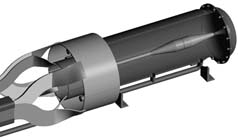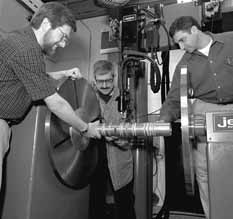 |
|
Physics in Progress by Mike Perricone Take a piece of equipment with a long and storied history, and subject it to what can accurately be described as unprecedented abuse. That's the plan for MiniBooNE's focusing horn, which will shape and direct the particle beam that produces neutrinos and hoped-for signs of neutrino oscillations.
"The design for the horn," said collaboration cospokesperson Janet Conrad, "is a work of engineering art." There are three primary conditions that make the MiniBooNE focusing horn unique in neutrino research: This horn will operate at five cycles per second (5 Hz), while other neutrino horns operate at less than one cycle per second. For example, the horn for Fermilab's long-baseline neutrino experiment, MINOS (Main Injector Neutrino Oscillation Search) will run at 0.5 Hz. The fastest horn so far, at Brookhaven National Laboratory, operates at 0.8 Hz. With its rapid repetition rate, this horn is designed for a lifetime of 100 million pulses. Each pulse consists of a jolt of 170 kiloamps of current lasting 150 microseconds. Historically, using somewhat higher current levels (200-300 kiloamps), neutrino horns have had a lifetime around 20 million pulses. When the MiniBooNE prototype is built, it will be tested for 20 million pulses; the testing process will thus be as long as the lifetime of previous horns.
The short, rapid pulses leave the horn vulnerable to resonance ("ringing"), which must be damped. The high frequencies excite all the natural frequencies in the horn, which could leave the horn "ringing" when the next pulse hits it. Resonance would multiply the amplitude of the pulses, exaggerating the stresses on the horn and greatly increasing fatigue.
In his research, Kourbanis noted that one anticipated procedure had to be ruled out. Coating or anodizing the aluminum to protect against corrosion from the water spray, he discovered, would actually exacerbate the effects of metal fatigue. The aircraft industry offers exhaustive data on the properties of various alloys of aluminum. But as Kourbanis found, much of the data is compiled to indicate a 50 percent failure rate at a particular stress point; the MiniBooNE horn required a certainty of more than 95 percent before a selection could be made. Fortunately, the search was easily resolved with the selection of an alloy widely used in building airplanes (designated 6061-T6, if you're keeping score at home), one offering high resistance to fatigue. Then came the design, which originally called for two horns, and called for their rapid production. On a tight budget, of course. Bartoszek worked at the Lab for 10 years, including contributions to the E760 charmonium fixed-target experiment, and the Antiproton Source, before going solo in 1993. He has consulted on projects throughout the worldwide high-energy physics community, from Fermilab to Brookhaven to Jefferson Lab to DESY to CERN. He credits a project for MIT's Bates Linear Accelerator called OOPS (Out Of Plane Spectrometer) with getting his consulting business off the ground. When MiniBooNE beckoned, Bartoszek brought a new view. "I wanted to look at what the real needs were from the beginning, and see if we couldn't do it more simply and cheaply," he said. Bartoszek, Kourbanis and Zimmerman developed a single horn to replace the two-horn system, reducing complications in the beam line and reducing costs without major penalties in physics capabilities. To produce a neutrino beam, protons are fired at a fixed target to produce pions, which are positive- or-negative-charged matter-antimatter pairs of a quark with an antiquark. The charged pions are then focused by the horn, which acts as a lens and organizes the pions into a beam that moves through a 50-meter decay pipe where the pions break down to form neutrinos. The horn bears make-or-break responsibilities: it must carry a lot of current, and the inner conductor must be as thin as possible to allow the pions to pass through without being absorbed. Because MiniBooNE operates at a lower beam energy than many previous neutrino experiments, the horn is significantly shorter. Thus, the pions experience only a small amount of material during their transit. This means the conductor can be slightly thickeróabout three millimeters instead of 1.5-to-2 millimetersómaking it somewhat sturdier. But how would the horn design play to reviewers? Zimmerman and Kourbanis organized the review for Feb. 7-9. It was chaired by Paul Czarapata, head of the engineering department in Fermilab's Beams Division. The committee consisted of David Pushka from NuMI and the Beams Division; Bob Trendler of the Particle Physics Division; and two neutrino horn experts from other labs, Stephane Rangod of CERN, and Bill Sims of Brookhaven. In addition to presentations on the MiniBooNE horn, and evaluations of the design and progress, the review offered an unusual feature. Rangod and Sims led a horn workshop, also attended by collaborators from the NuMI experiment. As Zimmerman explained, as enormous as the difference are between horns, the similarities are very importantóas were the expert insights of horn veterans such as Rangod and Sims. "This kind of interlab cooperation is a healthy thing, getting different labs to talk to each other," Conrad added. The committee has not submitted its final report, but the review turned into a success story for MiniBooNE. Said Czarapata: "The work done on the horn has been most impressive. It was a general feeling that no previous horn had been so well engineered in terms of stress calculations, material fatigue issues, water erosion, and structural resonance." And now: on to the building and testing of the prototype, with MiniBooNE on target to begin operations and data-taking late in 2001. |
| last modified 3/10/2000 email Fermilab |
FRLsDFx9eyfrPXgV
 "The design for the horn has to be as close to the edge as we can make it," said Eric Zimmerman, a Columbia University postdoc, whose perspiration is invested in the horn, along with that of project manager Ioanis Kourbanis of Fermilab, and Larry Bartoszek, a former Fermilab engineer who now has his own consulting firm in Aurora.
"The design for the horn has to be as close to the edge as we can make it," said Eric Zimmerman, a Columbia University postdoc, whose perspiration is invested in the horn, along with that of project manager Ioanis Kourbanis of Fermilab, and Larry Bartoszek, a former Fermilab engineer who now has his own consulting firm in Aurora.
 Factor in the heat and the magnetic forces generated by the current, and the complications added by welding and by spraying with cooling water, and the result is serious fatigueónot just fatigue for the designers handling all the details, but metal fatigue resulting from the repeated compression and tension in the six-foot-long, all-aluminum structure.
Factor in the heat and the magnetic forces generated by the current, and the complications added by welding and by spraying with cooling water, and the result is serious fatigueónot just fatigue for the designers handling all the details, but metal fatigue resulting from the repeated compression and tension in the six-foot-long, all-aluminum structure.